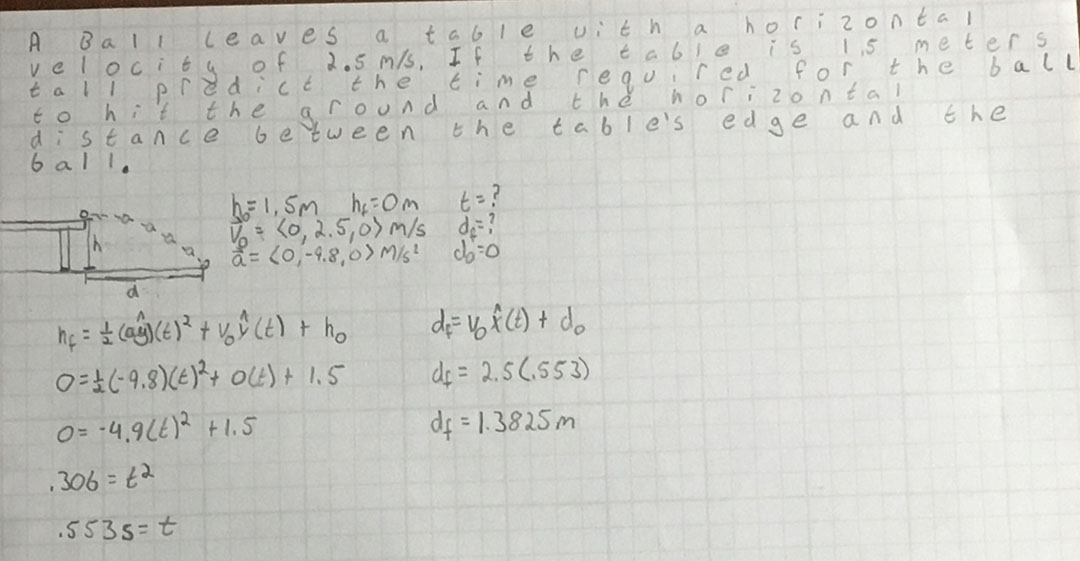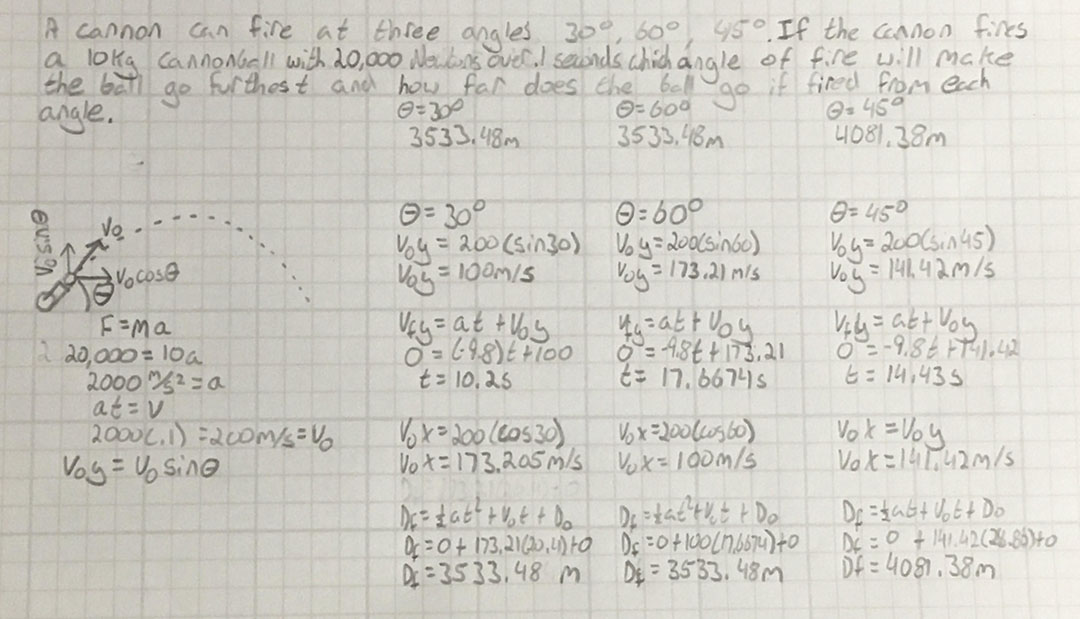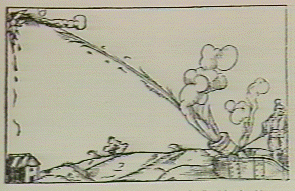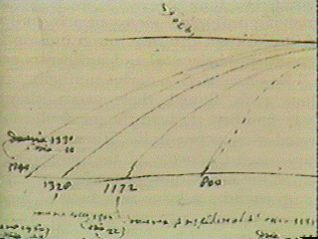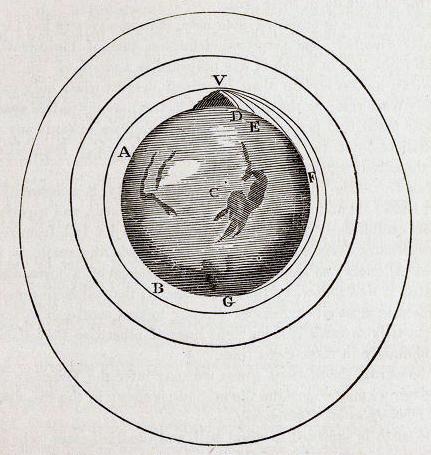Projectile Motion
This page will attempt to analyze projectile motion, a branch of classical mechanics in which the motion of an object (the projectile) is analyzed under the influence of the constant acceleration of gravity, after it has been propelled with some initial velocity.
The Main Idea
Projectile motion is a branch of classical mechanics which analyzes the motion of objects (projectiles) under the influence of the constant acceleration of gravity near the surface of the earth. Often, the projectiles are propelled prior to being analyzed under the influence of gravity, giving them initial velocities that affect their trajectories. Two classic examples of projectile motion are the firing of a cannon and throwing a ball off a tower, but there are many other examples of projectile motion. To be considered a projectile, the only force that can be acting upon the object is gravity. Note that for real projectiles, other forces such as air resistance are usually present, but these are usually negligible in magnitude and make the mathematical model significantly more complicated, so these are ignored. Regardless of the direction of motion of the projectile, the free-body diagram of a projectile is always the same, and constant throughout its trajectory: a particle on which only gravity acts in a downward direction.
A Mathematical Model
Traditionally, the Frame of Reference chosen for projectile motion problems places the origin on the ground below the point of launch and defines t=0 to be the time of launch. The +y direction is usually defined as vertically upwards, so the gravitational force acts in the -y direction. The +x direction is usually defined as the direction of the horizontal component of the projectile's velocity. No forces act in the x direction, so the x component of the projectile's velocity is constant throughout the trajectory. The y component of the velocity is constantly changing over time due to the gravitational force. Gravity near the surface of the earth causes a constant downward acceleration of 9.8m/s^2. This causes a parabolic trajectory. The constant velocity in the x direction and the constant acceleration in the y direction lend themselves to the Kinematic Equations. Kinematics are used to analytically solve problems related to projectile motion.
The following equations derived from kinematics describe the x and y components of a projectile's position as functions of time.
[math]\displaystyle{ y(t) = - \frac{1}{2} g * t^2 + v_{y, 0} * t + y_i }[/math]
[math]\displaystyle{ x(t) = v_{x, 0} * t }[/math]
It is evident from the above equations that the two components of a projectile's motion are independent; the particle's horizontal position has no effect on its vertical motion and vice versa.
[math]\displaystyle{ v_{y, 0} }[/math] and [math]\displaystyle{ v_{y, 0} }[/math] may each be positive, negative, or 0, depending on how the projectile was launched, resulting in a variety of trajectory shapes. Below are some possible trajectories of projectiles:
Note that all of these shapes are parabolic.
Sometimes, an initial speed and an initial angle (usually with respect to the horizontal) is given. In this case, [math]\displaystyle{ v_{y, 0} = v_0 \sin \Theta_0 }[/math] and [math]\displaystyle{ v_{x, 0} = v_0 \cos \Theta_0 }[/math].
Sometimes, rather than giving an initial velocity, a projectile motion problem will give the mass of the projectile as well as the magnitude, direction, and duration of the propelling force launching it. From this information, the relationship between Impulse and Momentum can be used to find the initial velocity of the projectile. In these situations, the propelling force is usually considered the only force acting on the object during the pre-trajectory impulse, because even if other forces are present, they are usually negligible compared to the propelling force.
At the highest point in a projectile's trajectory, the projectile's velocity is entirely horizontal; the vertical component is 0. This is because at that point in time, the vertical velocity has stopped being positive and is no longer carrying the projectile higher, but has not yet become negative and has therefore not begun lowering the projectile once more.
A Computational Model
One method used to visualize or predict a projectiles trajectory is to apply our mathematical model using computational programming. Computer models usually use Iterative Prediction rather than Kinematics to determine the path of the projectile. Here is an example of a program in vPython that simulates a projectile:
Click "view this program" on the top left corner to view the source code.
Examples
Additional examples of projectile motion can be found on the Kinematics page.
Simple Example
Middling Example
In the example above, the time of flight of each cannonball is determined by finding the time until its highest point and doubling that. This is possible because for this problem the ground is flat; if the cannonball ends up higher or lower than it starts, the time of flight will have to be found using its y-coordinate as a function of time. Once the time of flight is found, it is multiplied by the x component of its velocity to find its horizontal displacement.
As a challenge, consider trying to prove that 45[math]\displaystyle{ ^\circ }[/math] gives a greater range than any other angle, rather than comparing it to only 30[math]\displaystyle{ ^\circ }[/math] and 60[math]\displaystyle{ ^\circ }[/math]. Hint: find the range of the projectile as a function of the launch angle, then use optimization (show that the derivative of the function is 0 at [math]\displaystyle{ \Theta = }[/math] 45[math]\displaystyle{ ^\circ }[/math] and that therefore a maximum occurs there).
Additional examples of projectile motion can be found on the Kinematics page.
Connectedness
Understanding projectile motion was necessary for me to construct a Rube Goldberg machine which among other pieces contained a small catapult which launched a ping pong ball into a cup. To make the machine function properly I had to calculate the motion of the ping pong ball to place the cup in a position where it would catch said ball. One interesting industrial application of projectile motion is the creation of scopes for hunting rifles. A scope will usually have crosshair markings indicating the difference in distance of the animal from the hunter with the distance that the scope is calibrated to. This allows the hunter to aim more accurately at the animals he is hunting even if they are at a nonideal location. For example, if a hunter is 210 yards from a deer and his rifle is sighted for 200 yards he can aim at the deer with the dash on the scope which indicates +10 yards, or 10 more yards than his scope is sighted for. To find this distance, the scope makers must calculate the projectile motion of the bullet and determine how much higher to aim the rifle to hit a target 10 more yards away.
History
Major contributions to our current understanding of Projectile Motion
Aristotle
The first findings of Projectile Motion were contributed by Aristotle. He believed that a projectile modeled by a canon ball travels in a straight line until it lost its 'impetus'. When it lost its 'impetus' which ran out after time, due to a restive force, the projectile would immediately drop and fall to the ground. For objects projected over short distances, at first observation this can visually appear to be true.
Galileo
Galileo's findings were motivated by the Renaissance. At the time people were searching for a way to model 3-D objects in our 2-D world. Through as series of experiments he discovered that projectile motion is a result of Free Fall Motion along the y-axis and Uniform Motion along x-axis. This model is more well known and represents a more clearer understanding, one that is more widely accepted modern day.
Galileo proved that the vertical and horizontal motion of an object were unrelated. In other words, two objects will fall to the ground at the same rate if one is launched horizontally from the tower and the other object is simpy dropped. This is because each object has the same initial vertical velocity. Galileo also upended the beliefs of his time by proving that the curve of motion of a projectile was precisely parabolic.
Isaac Newton
Isaac Newton contributed to the idea of Projectile motion with his hypothetical cannon on a mountaintop. This hypothesis is now known as Newton's cannonball. Newton theorized that a cannon on top of a high mountain could fire a ball with varying forces for varying effects. A cannonball dropped off the mountain would merely return to earth, but if that cannonball were fired from a cannon then it would return to Earth in an arc, or parabolic shape. This would be considered projectile motion. Newton also extended this experiment to show universal gravitation, hypothesizing what orbit of the cannonball would look like.
See also
For more objects in motion see Curving Motion
Isaac Newton's The System of the World
External links
Interactive Projectile Simulator
Horizontally-Launched Projectiles
References
The following references were used while writing this page:
https://www.phy.duke.edu/~rgb/Class/intro_physics_1/intro_physics_1.pdf
http://www.physicsclassroom.com/class/vectors/Lesson-2/What-is-a-Projectile
https://vidphysics.blogspot.ca/p/blog-page.html
http://blogs.umass.edu/ndarnton/2009/02/28/projectile-motion-in-biology/

